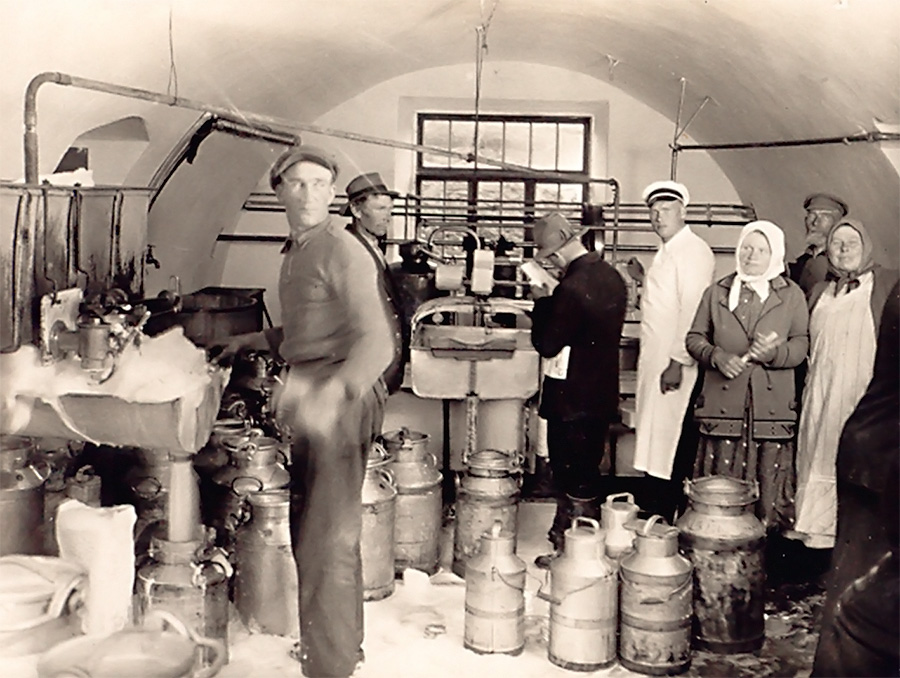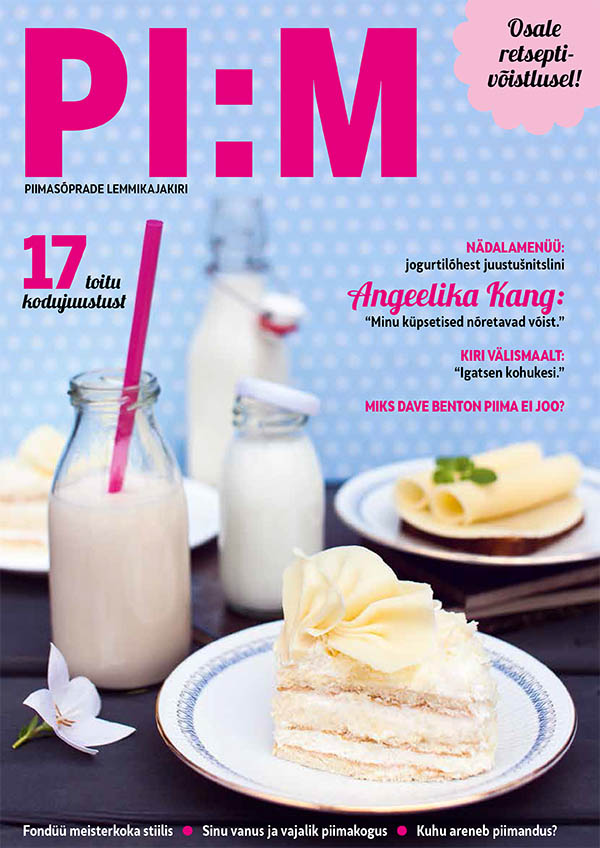Manor Dairies Get it Started | Wooden Equipment | Milk Brought Wealth to the Farms | The Time when Co-operation Triumphed | Export of Butter and Cheese | Bottled Milk and Giant Dairy Plants | Estonia as an Important Dairying Country
| Estonian Holstein Breed | Estonian Red Breed | Estonian Native Breed
Manor Dairies Get it Started
The rural people would say that the most beautiful manor ladies bathed in milk and only ate cream and butter. Whether this was true or not, the development of livestock manors also improved the living standard of the Estonians. Breeding bases were set up in the livestock manors.
Thanks to herd improvement and good animal care, the milk yield increased and the manors started to establish dairies. In addition, experts on livestock and dairy management were hired from abroad. Among them were butter masters from Denmark
and cheese masters from Switzerland, who taught the profession to the Estonians employed in the manor dairies.
At the end of the 19th century, 200 active manor dairies were working on either steam or horse power and producing mainly butter and Swiss cheese. Most of the dairies owned separators.
The production of dairy products in manors became increasingly important alongside vodka production. Inspired by the manors, home dairies were set up in farms.
Dairy cattle became the main source of main income in the countryside before the First World War.
Manors stressed the importance of breed improvement, dairies were established, favourable markets were sought, unions were created, and sales network developed. During the war years that followed, most of what had been achieved was unfortunately lost.
In 1918, Estonia declared its independence. After the land reform, the best herds were set up as national breeding bases, and the remaining herds were allocated to small-scale farmers.
Wooden Equipment
Butter and milk were not included in the everyday diet of old Estonian farm households. Generally, two milking cows were kept in each farm in the 19th century. There was enough milk for one’s own consumption in the summer, but in the winter, the cows did not milk as their winter diet consisted only of straw and swamp hay. The average annual milk production of farm cows was 360 kg.
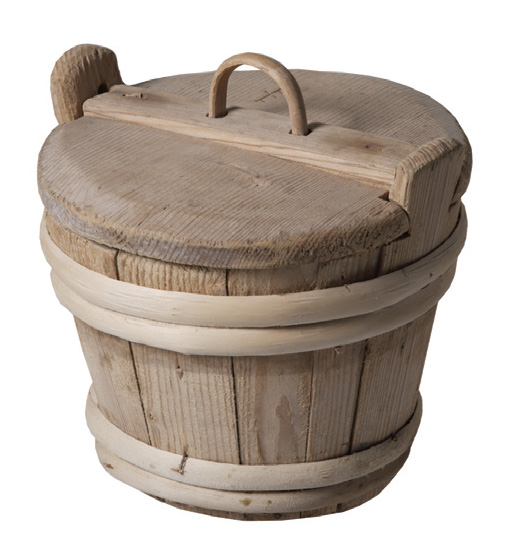 Milk utensils, as well as all other household equipment, were made of wood until the end of the 19th century. After milking, milk was poured into a special container that had a handle for carrying and a pipe for filtering. The filtering was done with the help of straw, juniper branches or a wad tucked in the pipe.
Milk utensils, as well as all other household equipment, were made of wood until the end of the 19th century. After milking, milk was poured into a special container that had a handle for carrying and a pipe for filtering. The filtering was done with the help of straw, juniper branches or a wad tucked in the pipe.
At the end of the 19th century, linen replaced the straw and other means, but the first filters were still wooden. Fresh milk was only used in milk soups; the families drank sour milk. Sour milk was a raw material for quark and quark cheese. At the end of the 19th century, tin containers replaced the woodenware.
Generally butter was produced once a week from sour cream; the water underneath was drained out through an opening close to the bottom edge of the cream container. Cream was processed mechanically: it was ground with a wooden spoon in a bowl, and for larger quantities, a special tool was used.
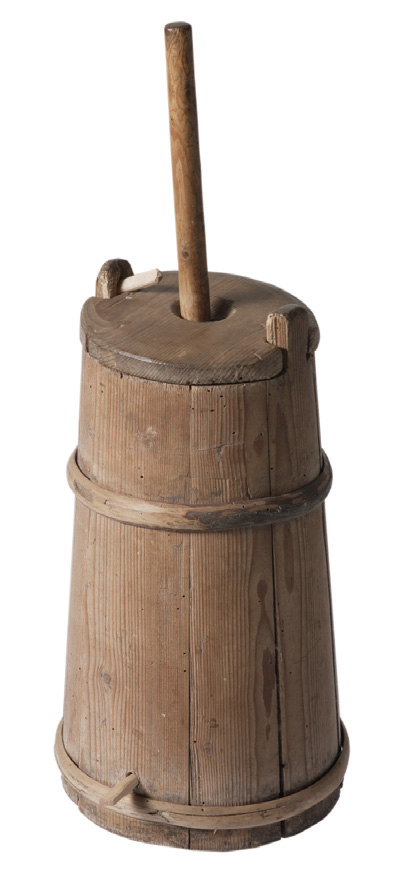 From the end of the 19th century, butter production was facilitated by box- or barrelshaped butter machines with a winch and turning vane inside. This equipment became common on farms at the beginning of the 20th century.
From the end of the 19th century, butter production was facilitated by box- or barrelshaped butter machines with a winch and turning vane inside. This equipment became common on farms at the beginning of the 20th century.
It was also at this time that manual separators made it to the farms and people started to make butter out of fresh cream. Farm people still rarely ate butter; however, in its salted form it became a marketing article.
Milk Brought Wealth to the Farms
The rural reform of the 19th century enabled people to buy farms. At this time, farmers discovered milk as a source of money. The number of labour animals was reduced on farms and cattle were bought instead. Following the example of the manors and improving the breed characteristics of cows, the farmers laid the foundation for the Estonian red and Estonian black and white breed. They learned how better feed and take care of the animals.
Soon farm production was large enough for private butter plants to be established in the villages, as it was no longer economical for everybody to produce and sell butter.
The end of century broadened the horizons of the new farmers. The media and farmers’ unions taught them about agriculture, co-operation, household economics, national politics, and culture. The farmers’ unions initiated all sorts of co-operation, such as common buying, trade enterprises, and banks.
The First Congress of the Estonian Farmers’ Unions in 1899 laid the basis for dairy co-operation. This turned out to be a well-organized network: most farms took the milk to dairies in 40-litre containers on horse carriages. Horses were used for milk transport until the1950s, when milk collection trucks replaced them. For pickup, milk was taken to milk stands that were built in all villages. During the Soviet period, which was established in 1940, no more than two cows were allowed per each household. Milk stands became meeting points for village people where one could get an overview of what was going on in the neighbourhood.
The Time when Co-operation Triumphed
The dairy herd is the foundation of Estonian farms and all Estonian agriculture – this understanding was fixed in the local farmers at the beginning of the 20th century. Small households had to arrange processing communally in order to benefit from this understanding.
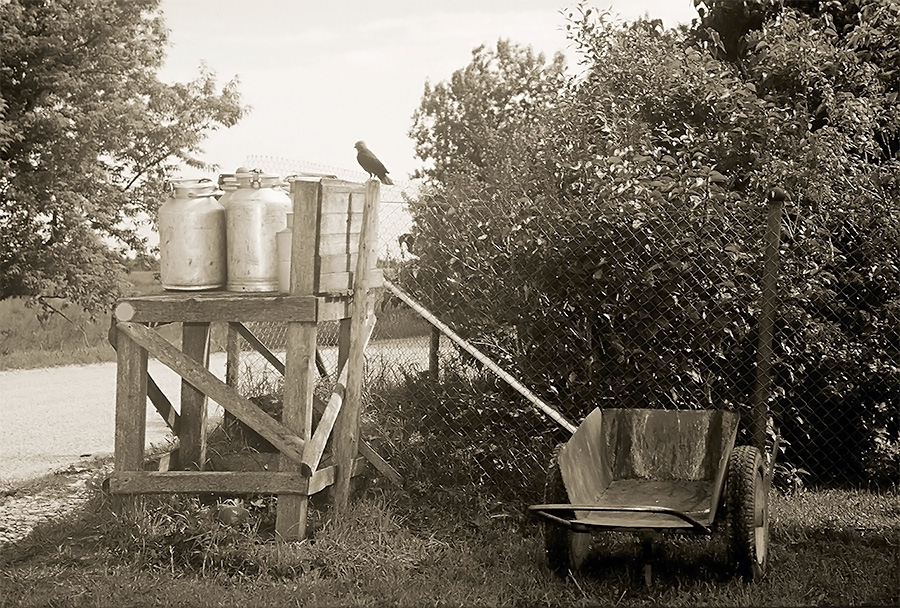 The first attempts to establish a co-operative dairy were started in 1897. The signing of the statute of the first co-operative was not signed until 1908 due to political reasons: the powers of Czarist Russian were afraid of any forms of co-operation.
The first attempts to establish a co-operative dairy were started in 1897. The signing of the statute of the first co-operative was not signed until 1908 due to political reasons: the powers of Czarist Russian were afraid of any forms of co-operation.
The successful dairy was the Imavere dairy in Viljandimaa that based its statutes on those of a Finnish co-operative. Today, the Imavere dairy building houses the Estonian Dairy Museum.
A typical Estonian farmer lived according to the principle that he is a man himself, but power lies in co-operation.
Denmark and Finland provided good examples and acted as driving forces, as did the co-operative businesses of the manors and private dairies. Soon it became evident that livestock rearing and agriculture developed better in the areas with successful dairies.
The First World War caused a serious setback in the development of the dairy sector. After the war and the establishment of the Republic of Estonia, the number of dairies grew rapidly. By 1934, the Estonian dairy industry was based almost exclusively on co-operation.
Export of Butter and Cheese
Milk is sometimes called the white gold of Estonia. Estonian butter already became an important export article during the second half of the 19th century. In 1888, the local landlords established a dairy union to facilitate the export of butter to England and Denmark. At the beginning, the leaders of the newly independent Republic did not favour the export of dairy products, claiming that food for the Estonian people was the priority. Upon the insistence of agricultural leaders, the embargo on exports of fatty matter was abolished in 1921. The government also began to demand quality control of dairy products to ensure that only the best and most expensive butter would be exported.
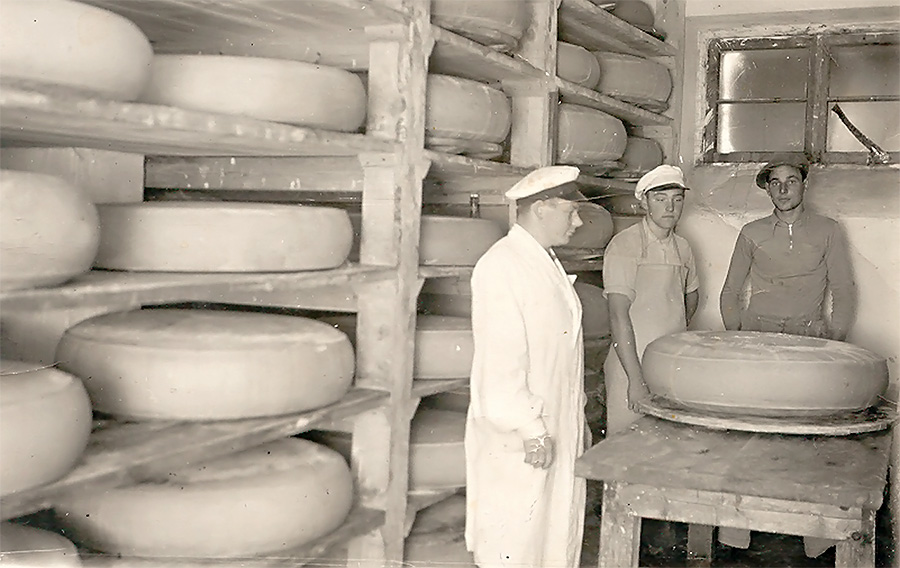 Therefore, a central laboratory – The Control Station for the Exports of Dairy Products started operations in 1924. Unfortunately, the over-orientation on exports struck Estonian agriculture hard when butter prices steeply decreased at the beginning of the 1930s.
Therefore, a central laboratory – The Control Station for the Exports of Dairy Products started operations in 1924. Unfortunately, the over-orientation on exports struck Estonian agriculture hard when butter prices steeply decreased at the beginning of the 1930s.
Butter exports amounted to a quarter of Estonia’s total exports and half of agricultural exports during 1924–1939. Two thirds of the butter was sent to England and one third to Germany.
Cheese export was not as successful. Manor dairies exported Swiss cheese to Russia, and a block of cheese had to weigh at least 65 kg. Private dairies also produced small Dutch-style cheeses. With the arrival of the Estonian Republic, the market situation changed: Swiss cheese was now exported to Europe and Dutch cheese to Russia.
Cheese production was still quite haphazard in Estonia and production volumes were not very stable through the years. When comparing exports of cheese and butter, in 1921 butter exports amounted to 110 tonnes and cheese only 3, in 1939 the respective volumes were 13, 816, and 381 tonnes.
Bottled Milk and Giant Dairy Plants
Estonia also remained an important dairy country in the Soviet Union; it started to supply the large cities with high quality dairy products. Agriculture was collectivised in 1948-1949 and it was only in 1965 that the pre-war level of Estonian milk production was achieved again.
With the industrialisation of agriculture that started in the second half of the 1960s, the collective farms were united into very large farms. In 1989, there was 350 sovkhozes and kolkhozes and 300, 000 cows, most of them in herds of 200-600 animals. In the mid- 1980s, total milk production reached the highest level of all times, and 1, 290, 000 tonnes of milk was produced in 1987. Exports of livestock products accounted for 35-37% of the total production at the end of the 1980s.
Right after the Second World War milk continued to be processed in numerous surviving dairy co-operatives. The entire existing dairy industry was nationalised in the 1950s and major changes started in the 1960s with restructuring, concentration, and specialization.
In the next 30 years new fresh milk dairy plants were built in Tallinn, Tartu, Paide, Pärnu, and Jõhvi, powdered milk plants in Põlva, Viljandi and Saaremaa, and a cheese plant in Võru. The old small dairies and creameries were gradually closed down. The number of dairy plants had fallen to 41 in 1980 from 212 in 1950. In the last years of the Soviet period, all the milk produced in Estonia was processed at nine dairy companies and two combined meat and dairy companies.
Estonia as an Important Dairying Country
Estonia remained an important dairying country during its incorporation into the Soviet Union. Immediately after the World War II, milk was still processed in numerous dairy co-operatives that had survived the war, but step by step old and small dairy industrial units and dairies were closed. In 1951, there were 212 dairy industrial units in Estonia; by 1980, their number had decreased to 41.
Agricultural reforms began in 1989 with the establishment of farmsteads. Restoration of independence in Estonia in 1991 turned a new page in the Estonian economy. Privatisation started both in agriculture and in the processing industry, and collective farms (kolkhozes) and state farms (sovkhozes) were liquidated. During the first decade of independence the production and consumption of milk decreased dramatically.
After Estonia joined the European Union, milk production in Estonia geared up again. New industrial units were built, equipment and technologies were modernised, and new dairy products were introduced to the market. Today, the number of dairy industrial units in Estonia is around 40, whilst 15 processing units are in the hands of five owners. There are also several distinctive small producers on the market who have found a niche for themselves, and who are producing interesting dairy products with exclusive ingredients or traditional national products.
Estonians value dairy products, and their everyday diet includes more cheese, fermented milk products and kefir, yogurts, fresh and sour cream than even just a decade ago. The selection of various dairy products in our stores is more diverse than in many other countries in the European Union.
Estonian Holstein Breed
1838 is regarded as the beginning of selective cattle breeding in Estonia, the year when they started to import black and white cattle of the Dutch Friesian breed ‑ the ancestors of the modern Holstein breed ‑ from Holland. Later, this breed was imported from Germany. Dutch Friesian cows were distinguished by their high milk yield. They had short legs, a wide compact body and they weighed 500kg and more.
Today, both the black and white, and red and white cows are known as Holstein dairy cattle; this breed has become the most numerous dairy breed in the world, being popular due to its high milk production compared with other breeds.
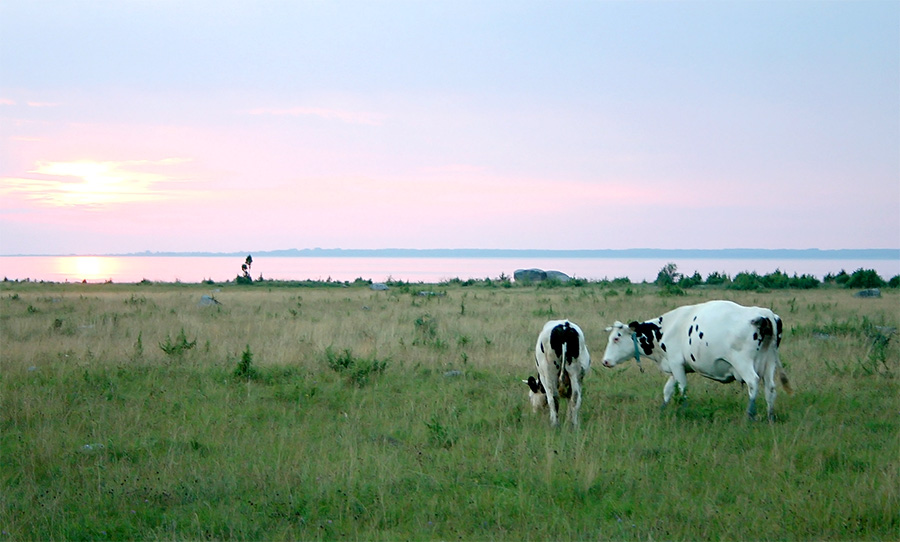 Selective breeding of Holstein cattle in Estonia began in 1975 when they started to improve the old Estonian Black and White breed using bull semen imported from the USA.
Selective breeding of Holstein cattle in Estonia began in 1975 when they started to improve the old Estonian Black and White breed using bull semen imported from the USA.
Today, our Holstein dairy cattle have longer legs, their bodies are longer and deeper, and body weights have increased – adult cows weigh over 700kg. The animals are calm and have a very good appetite.
In 1998 the Estonian Black and White breed was renamed the Estonian Holstein breed. The Holstein breed is suitable both for smaller farms as well as modern industrial farms with loose housing systems. The proportion of Holsteins has increased by one fourth during the last two decades, making up 77% of the total dairy cattle population of Estonia.
Today, the Estonian Holstein breed is known outside Estonia as well. Since regaining independence in 1991, heifers of Holstein breed have been sold to Latvia, Lithuania, the Russian Federation, the Ukraine, Uzbekistan, Poland, Holland, Malta, Spain, Romania, Moldova and Turkey.
Long-term purposeful breeding, the use of international breeding material, good breed type and high milk production, all speak in favour of the Estonian Holstein breed. It is also important that the cows come from dairy farms with a suitable herd structure that are free from infectious diseases.
The milk production of the Holstein breed cows has significantly increased during the last decade. 68,058 Estonian Holstein breed cows were subject to performance testing in 2009, and they milked on average 7,614 kilograms of milk each with 4.09% fat and 3.35% protein content. The milk production exceeded 8,000kg per head in 121 herds. In 2009, a new 305day production record was broken: 18,935 kilograms of milk and 1,365 kilograms of fat and proteins.
Vissi beauty competitions with international experts judging the candidates are held every year to nominate the prettiest cow of Holstein breed.
Estonian Red Breed
The selective breeding of the Estonian Red breed started at the same time as the selective breeding of other European breeds, and was developed as a result of a hundred years of selective breeding work. The Danish Red breed has influenced the development of this breed a lot. In improving the Estonian Red breed the following were used in crossbreeding: Angler, North-Schleswig, and Danish Red breeds.
In 1892, 21 Angler breed cows were imported from Germany, and this laid the foundation for the pure-breeding of Angler stock in the Estonian manors. Imported bulls were used to improve the local herds in crossbreeding. The acknowledged breeders in the 19th century were Academician Middendorff and Sievers, an instructor of Angler breeding.
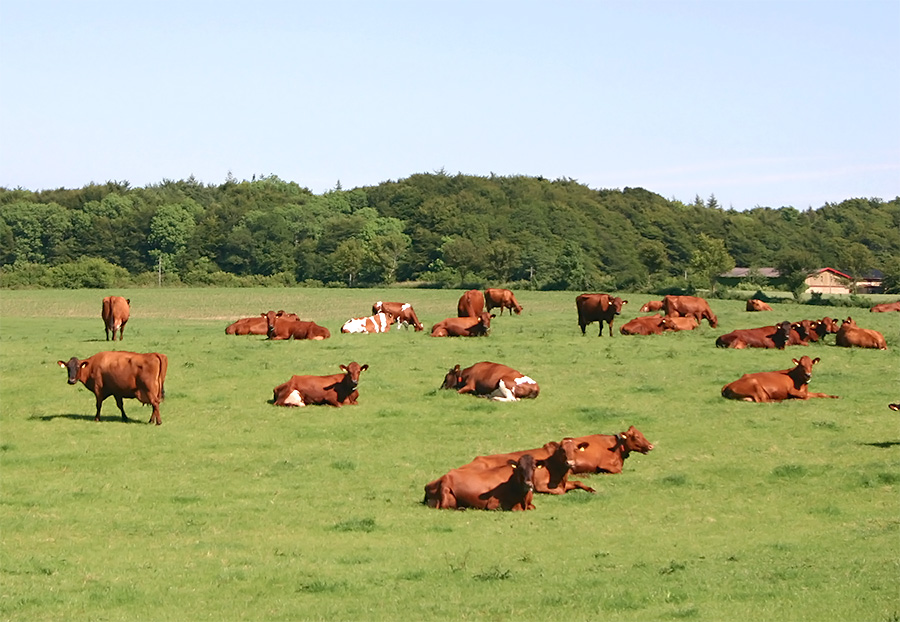 In 1885, the Baltic Cattle‑Breeders’ Association (established in 1885) started to register cattle in the herdbook which was first published in 1886 under the title “Balti aretuskarja tõuraamat” (Herdbook of Baltic Breeding Herd).
In 1885, the Baltic Cattle‑Breeders’ Association (established in 1885) started to register cattle in the herdbook which was first published in 1886 under the title “Balti aretuskarja tõuraamat” (Herdbook of Baltic Breeding Herd).
This was the first herdbook in the whole of Russia and speeded up the progress of selective breeding.
Much attention was paid to milk production first, and other characteristics were considered less important.
In the early 1890s, professor Stegmann began to promote cattle with stronger constitutions, and therefore the import of the Danish Red cattle started as they already had a big body weight and high milk productivity.
The Red cattle breed started to spread through Estonian farm herds at the end of the 19th century. Jaan Mägi, who considered the Angler breed to be best adapted to our conditions, was actively advocating breeding of the Red, and he set up the Estonian Angler Breeders’ Society in 1919. In 1926, he passed his work over to Aksel Mägiste. In 1928, Mägi renamed the Estonian Angler breed the Estonian Red breed, and the society was renamed the Estonian Red Cattle Breeding Society.
The Red breed has survived several ebbs and flows. Many valuable breeding herds were destroyed during World War I. World War II and the following collectivisation brought about another major setback. It was some time before milk production was restored. The best years during the Soviet times were from 1985 to 1990 when the highest milk production results per cow were achieved. In 1989, the average milk production per cow was 3,919kg, with 4.07% fat and 3.39% protein content.
The biggest number (168,053) of Red cows in Estonia was registered in 1975. Since then, the number has been gradually decreasing, there being only 20,578 cows at the end of 2009.
A new stage began in 1993 when the breeders of Danish Reds invited the breeders of the Angler, Lithuanian Red, Latvian Brown and Estonian Red cattle to Denmark. As a result of this meeting the European Red Dairy Breed Association was established, the main focus of which was increasing the protein content of milk, the health or disease resistance of cattle, ease of calving, and strong legs and cloven hooves.
Participation in the work of this association has offered good opportunities to the breeders of Estonian Red cattle to communicate with the European Red cattle breeders and to get valuable breeding material on favourable terms, helping to popularise the Estonian Red breed all over Europe.
A major breakthrough has been achieved in the milk production of the cows during the past years. There are many Red breed cows who milk over 10,000 kilograms of milk in a year. The record of the breed was achieved in 2009 with 16,051 kilograms. The average annual milk production of cows in many herds is over 8,000 kilograms.
The cow of the Estonian Red breed is calm and friendly. The breed is characterised by its red main colour, one that may vary from red, mottled red to brown colours depending on the breeding material from different countries (both light and dark tones are allowed). The colour black is not approved.
Estonian Native Breed
The history of the breeding of Estonian Native cattle goes back to the 19th century. The need to improve the local herd was first mentioned as early as 1803. The Estonian Native cattle breed has developed from the local aboriginal herd throughout the centuries, but purposeful measuring and evaluation of the cows of the Native breed and the selection of bulls began in 1909 lead by Aleksander Lilienblatt who had received special education in Finland.
The registration of the cows of the Native breed in the herdbook started in 1914. The Estonian Native Cattle Breeders’ Society was established on 20th April 1920 to better conduct the breeding work, the goal of which was a pale red and genetically polled dairy cattle of low or medium weight, with strong conformation and longevity, very productive and with milk of an especially high fat percentage.
Bull associations and stations were established for breeding. In 1939, there were 59 breeding centres for Native cattle in Estonia. The results of the purposeful breeding work carried out under the leadership of the society were remarkable. According to the records in the 1938/39 Estonian milk recording yearbook a cow of the Estonian Native breed produced 4.8 kg of milk fat with 100 feed units.
A dismissive attitude during the stagnation of the Soviet Union period deprived the breeders of the Estonian Native breed of their organisation – in 1947, the Estonian Native Cattle Breeders’ Society was liquidated and the improvement of Estonian Native cattle was co-ordinated by the other breeding centres. This was a big mistake which caused the breeding of Estonian Native cattle to stagnate for a long time. The number of Native cattle decreased to the critical point in terms of preservation of the breed – only 696 animals at the beginning of 1989.
At that time, the political situation in Estonia had started to change and people had the desire to develop a local cattle breed – the Estonian Native breed. In 1989, the Estonian Native Cattle Breeders’ Society was re-established on the initiative of Ain-Ilmar Leesment, and this marked the new beginning in the selective breeding of the Estonian Native cattle.
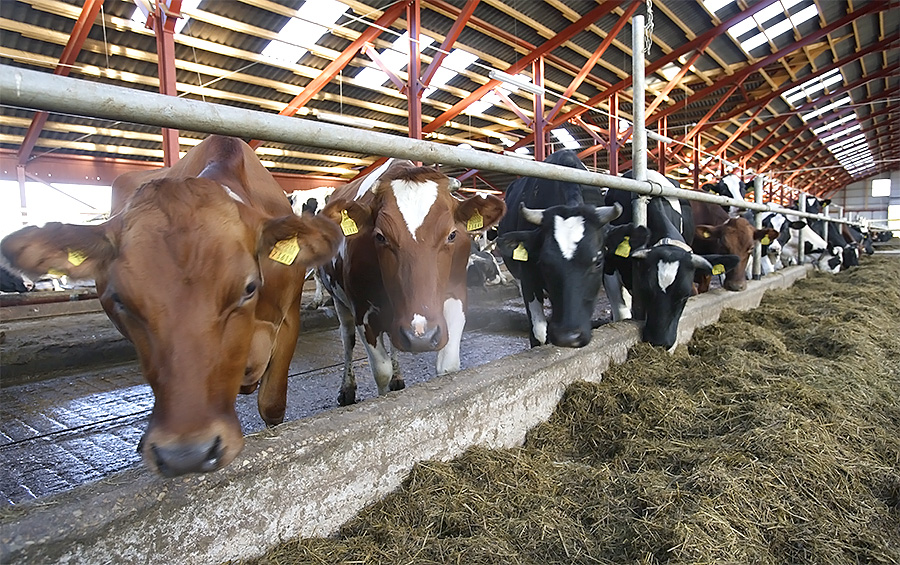 As of the 1st January 2010 there are 111 herds of Estonian Native cattle, with 713 animals, including 363 cows, in Estonia.
As of the 1st January 2010 there are 111 herds of Estonian Native cattle, with 713 animals, including 363 cows, in Estonia.
There are 11 breeding bulls in the nine herds, and the semen of 20 bulls of the Estonian Native breed is available in the Kehtna Artificial Insemination Station. The core of the Native breed comes from 24 breeding farms with 317 Native breed cows.
The Estonian Native breed is displayed on at least three nationwide fairs and competitions every year, and they choose the most beautiful cow of the Native breed at the Ülenurme exhibition.
The genetic milk production ability of the Estonian Native cattle has been studied in two feeding tests. In the Põlula experimental farm, the cows of the Native breed milked 6,000–8,500kg of milk in their first lactation in 2000–2002.
The results have improved year by year. The Estonian Native Cattle Breeders’ Society works closely together with the scientists of the Estonian University of Life Sciences. One of the ways of preserving the breed is to deep-freeze the embryos, the number of which is 103 at present. The Estonian Native cattle breed has been included in the „World Watch List for Domestic Animal Diversity” since 1993, a book that records the endangered species and breeds published by the Food and Agriculture Organisation of the United Nations.
Share ►

